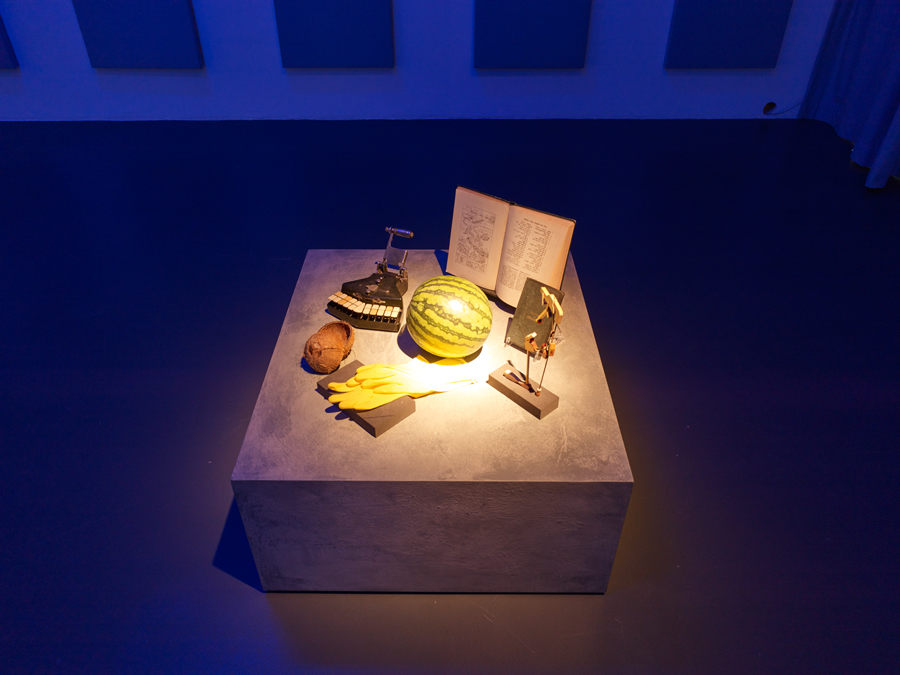Rana Hamadeh
Witte de With, Rotterdam, the Netherlands
Witte de With, Rotterdam, the Netherlands

On 29 November 1781, a group of white men decided to throw other humans into the sea. These men were the crew of Zong, a British slave ship owned by the Gregson slave-trading syndicate; the humans in question, their cargo. This mass murder was a matter of cold calculation. The ship’s owners intended to file an insurance claim on the black men, women and children thrown overboard following the principle of ‘general average’, which held that a captain who jettisoned part of his ‘cargo’ in order to save the remaining goods and voyagers could petition his insurers for the damages. This insurance claim represents the only existing documentation of the Zong massacre, which claimed the lives of 133 African slaves.
What kind of voice does this document speak with? And how might such a record structure and encode ‘valid’ speech – that which is admissible in a court of law? In Rana Hamadeh’s text On Proxy Bodies: A Script in Progress, which was written for this year’s Contour Biennale and functions as a prelude, of sorts, to the exhibition ‘The Ten Murders of Josephine’ at Witte de With, the artist poetically responds to the Gregson vs. Gilbert case: ‘For, thought is made in the mouth. / Let’s talk about the voice / of the record / as the record / Not of the captured, but of capture / Not of weight, but the modality of measure / The voice of the killer’. This excerpt gestures towards the voice’s different registers: sensual, powerful, potentially violent. The mouth is a container for the voice, the instrument that produces its logic and sonority. The mouth is the law, the voice its edict. It speaks the language of figures and losses, a grammar of numerical violence that reduces human life to a commodity value.

What about that which Hamadeh terms ‘absent speech?’ What might the voice that fills this absence sound like? How might we bend the mouth, the lips, to articulate sonic insurgency? These questions, sparked by cases like Gregson vs. Gilbert, comprise some of the core considerations of Hamadeh’s exhibition.
For nearly a decade, the Lebanon-born artist’s research- and performance-based practice has questioned the infrastructures of justice, militarism, histories of sanitation and theatre. ‘The Ten Murders of Josephine’ specifically examines the notion of the ‘testimonial’, which Hamadeh argues should be understood as a phonic trace of the ‘unspeakable’ rather than ‘the rational form of utterance bound to the workings of a tribunal’. The exhibition consists of a 40-minute sound- and text-based opera, which loops through the building’s dim, violet-lit second floor. The Egyptian superstar Umm Kulthum sings to god. A Yemeni work song morphs into grating techno. An actress whispers a line from the Gregson vs. Gilbert transcript before a subwoofer devours her voice. In Hamadeh’s composition, processes of translation and reordering articulate a shifting hierarchy of voices. However, such references are layered, distorted and coded beyond comprehension.

There is a twist in how Hamadeh leverages a hyper-rational aesthetic – systems of classification and notation – and confounds its logic. A graphic score, projected onto a wall in front of an outsized swing, brings together a hermetic universe of symbols: a horse’s head, a watermelon, a toy soldier. A light-box assembles theoretical, historical and political touchstones for ‘The Ten Murders of Josephine’ into a colour-coded cube, which is divided into ‘acts’ structured along axes of ‘reasoning, antagonism and association’. These references – ranging from the Shiite ritual of Ashura to the tribunal and the uterus – evince the power of the swerve. And herein lies the evocative force of Hamadeh’s method. As Sara Ahmed writes: ‘To swerve is to deviate […] What better way of learning about the potential to deviate than from the actuality of deviation. The swerve is just enough not to travel straightly; not to stay on course. Oh the potential of this not!’
Main image: Rana Hamadeh, 'The Ten Murders of Josephine', 2017, installation view, Witte de With Center for Contemporary Art, Rotterdam. Courtesy: Witte de With Center for Contemporary Art, Rotterdam; photograph: Kristien Daem






















